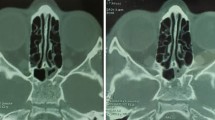Abstract
Isolated sphenoiditis (IS) is a relatively rare clinical entity which might present with serious complications. The clinical records of ten patients with IS were reviewed. The presenting symptoms, the findings, and the treatments given were noted. Eight patients were female and two were male, and their age varied between 9 and 65 years (mean 31 years). The main presenting symptom was headache in five patients, diplopia in four patients, and postnasal drainage in one patient. The duration of the symptoms ranged between 48 h and 1 year. The diagnosis was accomplished by history, nasal endoscopy and radiological examination (computed tomography and/or magnetic resonance imaging). Two patients had fungus ball. One patient was a scuba diver as a possible predisposing factor. All of the patients underwent medical treatment consisting of intravenous antibiotics or oral antibiotics, and endoscopic sinusotomy was performed in nine patients additionally. Complete resolution was obtained for all patients except one who had diplopia for one year. IS may present with headache and orbital symptoms. Timely diagnosis and treatment are substantial in order to avoid serious complications, and to obtain a complete recovery. Medical treatment does not avoid surgery in majority of cases. Surgery is indicated from the very beginning specifically for the cases starting with diplopia which might be suggestive of a progression of the infection. Currently the most frequently used approach is endoscopic transnasal sphenoidotomy. This technique seems to be effective and less traumatic compared to other approaches.





Similar content being viewed by others
References
Ada M, Kaytaz A, Tuskan K, Güvenç MG, Selçuk H (2004) Isolated sphenoid sinusitis presenting with unilateral VIth nerve palsy. Int J Pediatr Otorhinolaryngol 68:507–510
Brook I (2002) Bacteriology of acute and chronic sphenoid sinusitis. Ann Otol Rhinol Laryngol 111:1002–1004
Castelnuovo P, Pagella F, Semino L, De Bernardi F, Delù G (2005) Endoscopic treatment of the isolated sphenoid sinus lesions. Eur Arch Otorhinolaryngol 262:142–147
Deans JA, Welch AR (1991) Acute isolated sphenoid sinusitis: a disease with complications. J Laryngol Otol 105:1072–1074
Friedman A, Batra PS, Fakhri S, Citardi MJ, Lanza DC (2005) Isolated sphenoid sinus disease: etiology and management. Otolaryngol Head Neck Surg 133:544–550
Haimi-Cohen Y, Amir J, Zeharia A, Danziger Y, Ziv N, Mimouni M (1999) Isolated sphenoidal sinusitis in children. Eur J Pediatr 158:298–301
Hnatuk LA, Macdonald RE, Papsin BC (1994) Isolated sphenoid sinusitis: the Toronto Hospital for Sick Children experience and review of the literature. J Otolaryngol 23:36–41
Kieff DA, Busaba N (2002) Treatment of isolated sphenoid sinus inflammatory disease by endoscopic sphenoidotomy without ethmoidectomy. Laryngoscope 112:2186–2188
Lahat E, Danieli J, Cohen H, Paret G, Barzilai A (1997) Acute isolated sphenoid sinusitis in children. Pediatr Infect Dis J 16:1180–1182
Lawson W, Reino AJ (1997) Isolated sphenoid sinus disease: an analysis of 132 cases. Laryngoscope 107:1590–1595
Lew D, Southwick FS, Montgomery WW, Weber AL, Baker AS (1983) Sphenoid sinusitis. A review of 30 cases. N Engl J Med 309:1149–1154
Marseglia GL, Pagella F, Licari A, Scaramuzza C, Marseglia A, Leone M et al (2006) Acute isolated sphenoid sinusitis in children. Int J Pediatr Otorhinolaryngol 70:2027–2031
Oruckaptan HH, Akdemir P, Ozgen T (2000) Isolated sphenoid sinus abscess: clinical and radiological failure inpreoperative diagnosis. Case report and review of the literature. Surg Neurol 53:174–177
Rothfield RE, de Vries EJ, Rueger RG (1991) Isolated sphenoid sinus disease. Head Neck 13:208–212
Sethi DS (1999) Isolated sphenoid lesions: diagnosis and management. Otolaryngol Head Neck Surg 120:730–736
Shono T, Nishio S, Muratani H, Yasuda T, Fukui M, Moutai K (1999) Pituitary abscess secondary to isolated sphenoid sinusitis. Minim Invasive Neurosurg 42:204–206
Stankiewicz JA (1989) Sphenoid sinus mucocele. Arch Otolaryngol Head Neck Surg 115:735–740
Tan HK, Ong YK (2004) Acute isolated sphenoid sinusitis. Ann Acad Med Singapore 33:656–659
Urquhart AC, Fung G, McIntosh WA (1989) Isolated sphenoiditis: a diagnostic problem. J Laryngol Otol 103:526–527
Wang ZM, Kanoh N, Dai CF, Kutler DI, Xu R, Chi FL et al (2002) Isolated sphenoid sinus disease: an analysis of 122 cases. Ann Otol Rhinol Laryngol 111:323–327
Conflict of interest
The authors declare that they have no conflict of interest.
Author information
Authors and Affiliations
Corresponding author
Rights and permissions
About this article
Cite this article
Güvenç, M.G., Kaytaz, A., Özbilen Acar, G. et al. Current management of isolated sphenoiditis. Eur Arch Otorhinolaryngol 266, 987–992 (2009). https://doi.org/10.1007/s00405-008-0873-8
Received:
Accepted:
Published:
Issue Date:
DOI: https://doi.org/10.1007/s00405-008-0873-8




